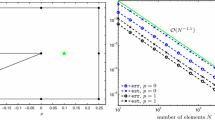Abstract
In this paper, an iterative algorithm based on the conjugate gradient method (CGM) in combination with the boundary element method (BEM) for obtaining stable approximate solutions to the Cauchy problem for Helmholtz-type equations is analysed. An efficient regularising stopping criterion for CGM proposed by Nemirovskii [25] is employed. The numerical results obtained confirm that the CGM + BEM produces a convergent and stable numerical solution with respect to increasing the number of boundary elements and decreasing the amount of noise added into the input data.
Similar content being viewed by others
Author information
Authors and Affiliations
Additional information
Received: 5 November 2002 / Accepted: 5 March 2003
L. Marin would like to acknowledge the financial support received from the EPSRC. The authors would like to thank Professor Dinh Nho Hào and Dr. Thomas Johansson for some useful discussions and suggestions.
Rights and permissions
About this article
Cite this article
Marin, L., Elliott, L., Heggs, P. et al. Conjugate gradient-boundary element solution to the Cauchy problem for Helmholtz-type equations. Computational Mechanics 31, 367–377 (2003). https://doi.org/10.1007/s00466-003-0439-y
Issue Date:
DOI: https://doi.org/10.1007/s00466-003-0439-y




